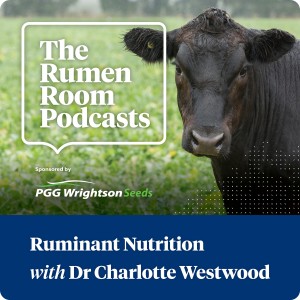
Tuesday Oct 17, 2023
41. Internal parasite management– the role for good nutrition (plus many other parasite topics!)
Our latest episode features guest speaker Dr Ginny Dodunski who joins Rumen Room host Dr Charlotte Westwood for a chat about all things internal parasites. As a New Zealand-based veterinarian and self proclaimed “gumboot parasitologist”, Ginny requires little introduction to most kiwis involved in farming. With a background in veterinary practice, farm consultancy and more recently, working part time with Wormwise, Ginny joins us to cover a range of topics relating to internal parasite management in sheep and cattle.
Given the concerning scale of resistance by internal parasites to our range of anthelmintic (drench) products, Ginny steps us through a range of down to earth, practical recommendations to managing internal parasites – including the important role for top quality nutrition for maternal and young stock.
Anyone who is involved in managing young stock should tune in - there will be some practical tips and tricks for everyone.
Have a scroll (below) through the content for our latest episode featuring Ginny Dodunski.
0.50 Ginny’s background and how her passion for all things animal health, and how her journey working with internal parasites began.
6.05 The timeline of New Zealand resistance since the days of effective anthelmintics
7.00 The cost of internal parasites (including resistance issues) to the New Zealand pastoral industries - and at the level of individual farms
8.40 The novel drenches, Zolvix™ Plus (monepantel and abamectin) and Startect® (derquantel and abamectin) help uncover the true cost of internal parasite resistance in lambs
9.50 Picking up sub-clinical internal parasite challenges (or not!) – especially when other autumn health challenges are occurring
12.10 Who to talk to if you suspect internal parasite resistance issues at your place
13.45 Is my drench working or not? Faecal egg counts
15.15 Starting the internal parasite journey – starting with the ewe/lamb(s) unit
16.25 Higher lambing percentages and internal parasite challenges (and opportunities)
18.40 Well fed ewes support good lamb weaning weights, reducing numbers of lambs on farm post-weaning
22.40 Anthelmintic treatments for ewes pre-lambing (or not)
24.10 Ewe nutrition and body condition– building tolerance to internal parasites
28.35 Hatching and development rates of larvae – differs for eggs from ewes and lambs
30.20 Ewe stocking rate combined with other stock classes – optimising ewe nutrition
32.50 Three Pillars of Parasite Management
33.30 First Pillar = well fed, healthy robust breeding stock
33.35 Second Pillar = young stock on clean feed (less worm larvae than average hill country pasture)
34.40 What’s the best crop for lambs?
37.45 Feeding lambs the best quality feed that you can – the Third Pillar
38.10 Gross margin analyses on forage crops – understates the value of crops for young stock
39.00 Preparing pasture areas to finish lambs on – integrating cattle with sheep
40.00 100kg calves (dairy replacements, dairy beef) and internal parasites
43.00 Buying in 100kg calves – cautions around risk of parasite resistance
44.20 Holding young stock in yards to empty out after quarantine drenches
46.30 Faecal egg counting in young cattle – usefulness for different ages of cattle
48.40 Trace elements / trace minerals and internal parasites
52.05 Where to go to learn more about internal parasites
No comments yet. Be the first to say something!